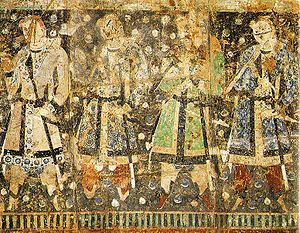
Kizil Caves
Encyclopedia

Buddhism
Buddhism is a religion and philosophy encompassing a variety of traditions, beliefs and practices, largely based on teachings attributed to Siddhartha Gautama, commonly known as the Buddha . The Buddha lived and taught in the northeastern Indian subcontinent some time between the 6th and 4th...
rock-cut caves located near Kizil Township (克孜尔乡) in Baicheng County
Baicheng County
The Baicheng County is a county in the Aksu Prefecture of the Xinjiang Uyghur Autonomous Region, People's Republic of China. The county's land area is 15,889 km2...
, Xinjiang
Xinjiang
Xinjiang is an autonomous region of the People's Republic of China. It is the largest Chinese administrative division and spans over 1.6 million km2...
, China
China
Chinese civilization may refer to:* China for more general discussion of the country.* Chinese culture* Greater China, the transnational community of ethnic Chinese.* History of China* Sinosphere, the area historically affected by Chinese culture...
. The site is located on the northern bank of the Muzat River
Muzat River
The Muzart River or Muzat River is a river in Aksu Prefecture of Xinjiang Uyghur Autonomous Region, People's Republic of China, a left tributary of the Tarim River...
75 kilometres (by road) northwest of Kucha. This area was a commercial hub of the The Silk Road
Silk Road
The Silk Road or Silk Route refers to a historical network of interlinking trade routes across the Afro-Eurasian landmass that connected East, South, and Western Asia with the Mediterranean and European world, as well as parts of North and East Africa...
.
The caves are said to be the earliest major Buddhist cave complex in China, with development occurring between the 3rd and 8th centuries. Although the site has been both damaged and looted, at least 1000 square metres of wall paintings—mostly Jataka
Jataka
The Jātakas refer to a voluminous body of literature native to India concerning the previous births of the Buddha....
stories—remain.
See also
- KuchaKuchaKuchaor Kuche Uyghur , Chinese Simplified: 库车; Traditional: 庫車; pinyin Kùchē; also romanized as Qiuzi, Qiuci, Chiu-tzu, Kiu-che, Kuei-tzu from the traditional Chinese forms 屈支 屈茨; 龜玆; 龟兹, 丘玆, also Po ; Sanskrit: Kueina, Standard Tibetan: Kutsahiyui was an ancient Buddhist kingdom...
- Bezeklik Thousand Buddha CavesBezeklik Thousand Buddha CavesThe Bezeklik Thousand Buddha Caves are complex of Buddhist cave grottos dating from the 5th to the 9th centuries between the cities of Turpan and Shanshan at the north-east of the Taklamakan Desert near the ancient ruins of Gaochang in the Mutou Valley, a gorge in the Flaming Mountains, China...
- Mogao CavesMogao CavesThe Mogao Caves or Mogao Grottoes , also known as the Caves of the Thousand Buddhas , form a system of 492 temples southeast of the center of Dunhuang, an oasis strategically located at a religious and cultural crossroads on the Silk Road, in Gansu province, China...
- Ajanta Caves
- The Silk RoadSilk RoadThe Silk Road or Silk Route refers to a historical network of interlinking trade routes across the Afro-Eurasian landmass that connected East, South, and Western Asia with the Mediterranean and European world, as well as parts of North and East Africa...

